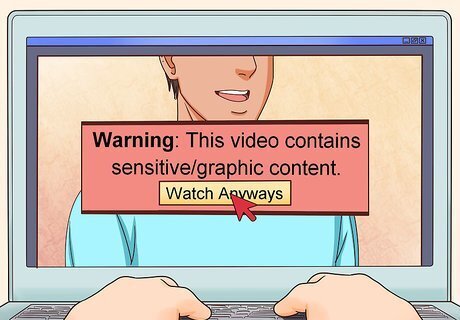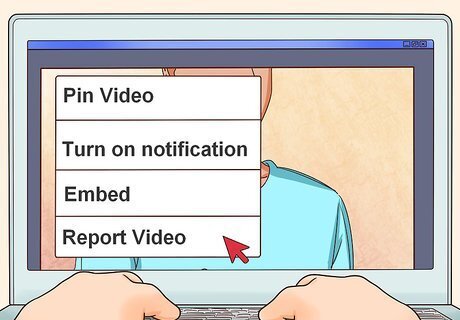
views
Overwriting the Memory

Use thought substitution to overwrite the horrible image. The idea behind thought substitution (sometimes called thought displacement) is that you have the ability to control what you think and how you react. You can intentionally forget bad memories by filling your mind with more positive things. Your brain has a limited focus, and you can only keep so many thoughts in your immediate sphere of awareness. Try to replace the negative memory by exposing your brain to something brighter. Watch a happy or inspirational video, lose yourself in a story, or just look at pictures of cute animals. Try to redirect your attention to whatever activity you're doing to bring yourself back to the present.

Replace the memory with something positive, but equivalent. Thought substitution works best when there is some relation between the replaced thought and the "overwriting" thought. Thus: if you watched a horrifying video, find an inspirational video that grips your emotions just as powerfully. If you saw a nasty picture, look at images that make you smile. If you read something that triggered you, try reading a story that calms your mind.

Do something positive. Video chat with a friend, play a sport, or do some yoga. Do something wholly unrelated to the internet, especially if it can get both your mind and your body moving.

Look at pictures of something that makes you happy. Browse lists of memes or photos of cute animals. Scroll through photos of something dear to you: good memories with friends and family, pictures of pets, pictures of places. Run a web image search for, say, "cute baby pandas" or "lazy sloths" to find the photos you need.

Watch positive videos. Browse comedy videos on YouTube, or watch an episode of your favorite show. Look for videos of simple things: a baby laughing, an ecstatic puppy, or someone smiling. Find videos of peaceful things: the lull of the waves, the hum of a summer forest, or a panoramic mountaintop view. Run a web search for the sort of videos that you want to find. Search for "happy videos" or "puppy playing" to find content to soothe your mind. Check out YouTube Haiku for short but absorptive videos.
Suppressing the Memory

Try to push down the memory whenever it emerges. Suppressing memories, like thought substitution, has been proven to help people forget negative memories. Your negative memories are usually linked to "triggers" that remind you of what you saw and how you felt. If you can force yourself to ignore the memory when it comes back into your head, you might be able to break these "episodic" links and let go.

Understand how memory suppression works. Cognitive scientists divide memories into two patterns: episodic and semantic. Episodic memory is experiential and subjective, while semantic memory is factual and objective. When you see something horrible online, it triggers an immediate and viscerally negative reaction, and it is linked in your episodic memory to things that remind you of what you saw. By forming new associations with these triggers, you may be able to gradually "forget" what you saw. Episodic memory is our mode of remembering specific things that we've experienced. These memories are usually tied to the emotional context of what happened. Thus, the memory of this horrible thing that you saw might be linked to triggers that continually bring back the image. Semantic memory is a more structured record of facts, meanings, ideas, and observations about our external world. Our brains tend to store this knowledge independently from our personal experience. Semantic memory does not usually include the emotional context.

Practice letting go. If you came across an especially horrific thing online, there's a good chance that the image pops up in your head from time to time. Try to catch your thoughts and turn them around. You can do this in two ways: you can "let go" of the thought by confronting it and coming to terms with it, or you can "suppress" the thought by pushing it deeper into your mind. When your mind turns to a dark place, try to consciously turn your awareness toward brighter things. You can look up or you can look down.
Moving Forward

Go outside. Leave the Internet behind for a while, and try to immerse yourself in the world around you. Catch up with some friends, or go for a run, or go spend time in nature. Fix your mind in the present moment, and do something you love. The horrible thing that you saw online may seem much more abstract once you've stepped away from the keyboard and involved yourself in more relevant things.

Be more careful when browsing the web. The Internet projects the dark depths and the soaring heights of the human condition. It is a maze of code, and each click is a step around an unknown corner. You might encounter something beautiful that inspires you to change your life – or you might come across something utterly soul-crushing. Think before you click. Try to be aware of the context of each click that you make, and ask yourself whether you trust the source that provided the link. Do your best to figure out what you're going to see when you click the link. Ask yourself whether that's something that you want in your head. Consider using an Internet filter. Most Internet filtering services can be configured to block websites hosting certain types of inappropriate content, such as pornography and violence. Set the filter to block categories of sites that you wouldn't feel comfortable looking at. Note that it may not always be easy to tell if the content is safe or not. Some people don't put filters on their inappropriate content, and there are even some terrible people that hide upsetting/disgusting content behind something that seems innocuous or even enticing. Try to only look at content from people you trust, and maybe even pause and check the comments before proceeding.

Report illegal content. If you came across something illegal and obviously harmful, consider reporting it to your local police station. It can be hard to track down Internet criminals, but it's been done before. Think about examples of situations that might beg further action: Someone posted photos of a dog that had been horribly abused. The photos were posted to a local forum, and you think there's a good chance that the poster was physically abusing this dog in your area. Someone posted child pornography or other evidence of child abuse. Not only is this activity illegal, but it is harmful to children. For all you know, a child's life could be at stake.


















Comments
0 comment